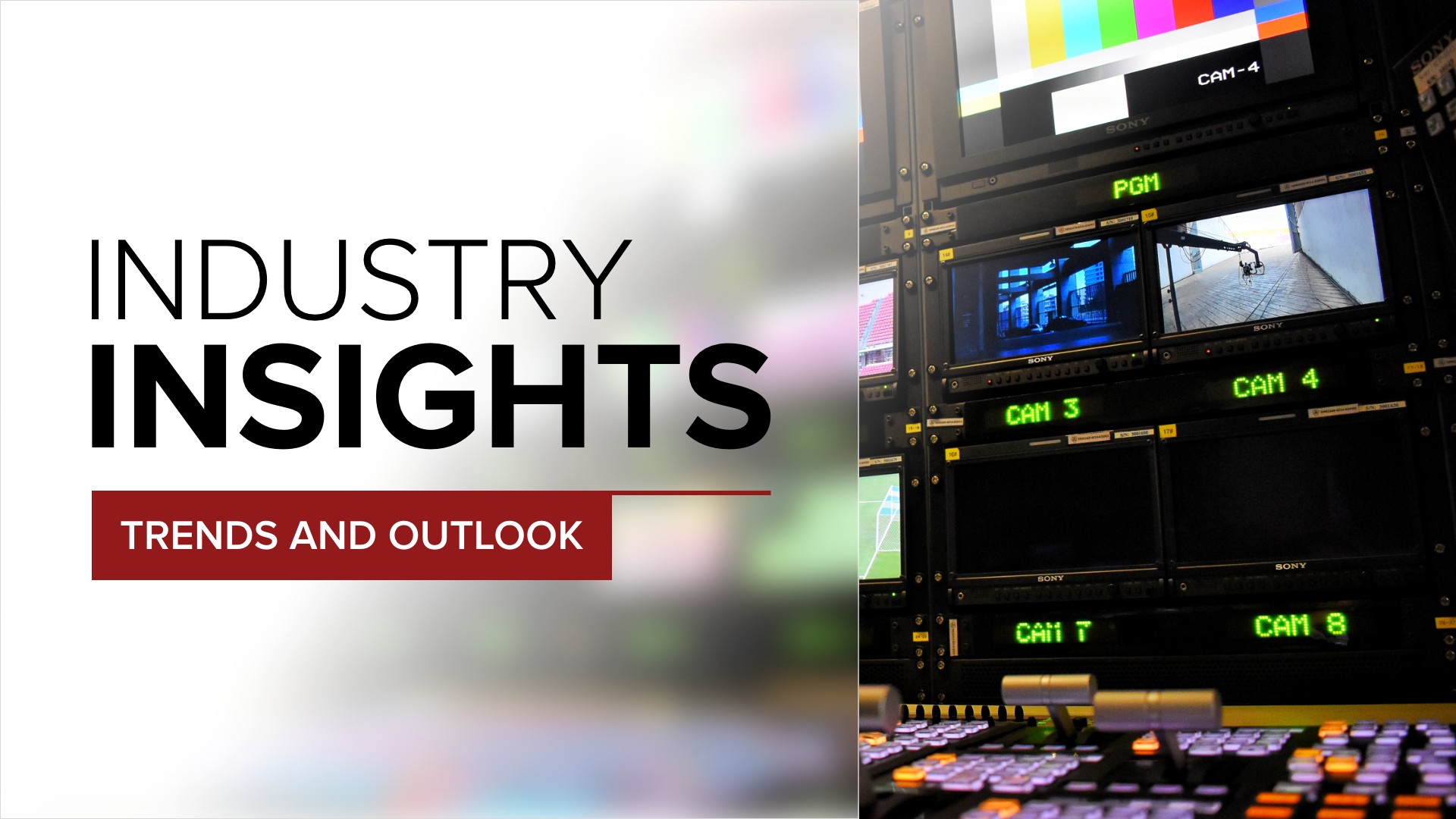Industry Insights: Distribution and delivery pros talk 2022 outlook

Weekly insights on the technology, production and business decisions shaping media and broadcast. Free to access. Independent coverage. Unsubscribe anytime.
Earlier this year, we spoke with professionals and changemakers all across the broadcast industry to get their outlook on the upcoming year.
This Industry Insights roundtable features answers from those whose companies specialize in broadcast distribution and delivery including playout, streaming, file transfer and broadcast monitoring.
Explore the other parts of this roundtable:
- Acquisition including Cameras, Transmission, Audio and Studio Gear
- Production including Creative Services, Graphics and XR Solutions
- Infrastructure including Hardware and Software Infrastructure
- Distribution & Delivery including Automation, Playout, Streaming, File Transfer and Monitoring
What is your 2022 outlook?
Paul Matthijs, co-founder and CEO, Hedge: We’re positive. Everyone’s frustrated that we’re not back to “normal,” but the industry has quickly adapted and will continue to do so even more. Meanwhile, we’re multiplying our R&D efforts to speed up product development with an eye on the future but also on existing day to day weaknesses and pain points in production workflows.
Russell Wise, senior VP of sales and marketing, Digital Nirvana: As we go into 2022, we’ll be highlighting Trance , our easy-to-use, web-based application that automatically generates transcripts, closed captions/subtitles, and translations for content localization. Advanced speech-to-text engines create highly accurate text transcripts of audio and video content. Also in 2022, we will address the critical need among video distributors to replace the antiquated Slingbox and obsolete Volicon RPM, which provided remote edge video monitoring.
Jon Finegold, CMO, Signiant: One interesting theme we hear from customers is a need for a much lighter-weight, simpler, more productized approach to workflow implementation. Customers will still require best-of-breed optionality and a high level of configurability; but complex, one-off deployments simply cannot deliver the necessary flexibility and economies of scale. This trend is what drove Signiant to acquire Levels Beyond, makers of Reach Engine in November of 2021.
Ralph Bachofen, VP of sales and marketing, Triveni Digital: We expect 2022 to be another outstanding year for NextGen TV, as ATSC 3.0 deployments ramp up in the U.S. As we move into a more production-oriented ATSC 3.0 deployment environment, real-time monitoring is becoming a critical requirement for broadcasters. Broadcasters are looking to streamline NextGen TV operations.
Bill Admans, COO, Ateliere: I am bullish on our outlook for 2022. Last year we more than tripled the amount of content processed by the Ateliere platform, and we expect even more significant growth this year. Customers are going all-in on cloud adoption and its benefits for their business success. If our early bookings are anything to go by, 2022 will be a very productive year.
Brian Rifkin, co-founder & SVP of partnerships, JW Player: With the meteoric growth of connected television and the opportunities afforded by hybrid monetization models on the spectrum between AVOD and SVOD, 2022 will be an excellent year for the industry. As more consumers get subscription fatigue, freemium and TVOD models will be attractive options that can drive growth and revenue for content owners.
Malik Khan, CEO and co-founder, LTN Global: The shift towards viewer content consumption via digital platforms will continue to accelerate. Leading content providers are working with their technology partners to develop flexible and scalable ways to create outstanding live content at an unprecedented scale, spin up new channels rapidly, decorate, customize, monetize them for specific geographies and platforms, and efficiently distribute them.
Van Duke, director of U.S. operations, PlayBox Neo: We’ve been busy on projects ranging from system updates to a total renovation of our playout infrastructure. Whether it’s on-premise, remote, owned, leased, SaaS or a combination, we’re ready to deliver TV channel management, branding and playout that’s easier to use.
Alison Pavitt, director of sales and marketing, Pebble: A strong 2021, a host of new developments coming on stream, and a trusted portfolio of products all position Pebble well for 2022. As we enter the third Covid-affected year our user base and the wider industry is pushing ahead with expansion and transformation plans, and we’re already seeing a growth in broadcasters exploring our flexible hybrid solutions,
Ciarán Doran, director of marketing for boadcast and media, Rohde & Schwarz: 2022 will be a positive year where our industry will review what we learned from being forced down a different road. The disruptive OTT broadcasters and VOD companies, who adapted rapidly to the new normal, have delivered a shock to mainstream broadcasters who now need to catch up.
Kevin Joyce, Zer0 Friction officer, TAG Video Systems: The key to successful, future-proof solutions and technologies lies in a vendor’s ability to remain flexible as consumers’ appetites for entertainment morph with an evolving environment. Streaming will only grow more popular and the technologies that provide content owners and broadcasters with the tools to ‘read’ the audience, respond to their wants and needs, and engage new viewers will own the future.
John Wastcoat, senior VP of alliances and marketing, Zixi: 2021 was a year of rapid growth for live IP video and we see the trend continuing in 2022. Major broadcasters are setting finite dates for satellite replacement and 5G deployments are real, starting with in-venue applications and moving more broadly.
Russell Johnson, director, Hitomi: We have an incredibly positive outlook for the year ahead. We are preparing to launch new latency feature for Matchbox, which measures the actual time of flight of video signals from the front of multiple cameras or at various points through the broadcast chain with millisecond accuracy. It has a wide range of applications.
Steve Reynolds, president, Imagine Communications: We are seeing successful customers around the world building on the fundamental cornerstones of standards-based IP platforms, unified origination of content with highly automated operations, virtualization and adoption of cloud, cross-platform advertising and optimization, and a forward-looking migration towards cloud.
Lacie Romano, director of global marketing, Visual Data Media Services: AI will become an even more critical component in meeting demand. And that demand is global. Consumer appetite for localized content is going to reach new levels in both demand and quality expectations. Improved AI along with adapted workflows that address the growing quality requirements will drive an evolution in language services making way for new opportunity and innovation in the space.
What trends are you watching in 2022?
Paul Matthijs: Production had to jump from on-premise to remote working within a week or two. It could have been a disaster but turned out to be a measured success. Now it’s time to learn from what went right and what didn’t go so well, build a hybrid infrastructure where no one, wherever they are, is at a disadvantage, and where we can reap the opportunities and benefits that come from flexible remote working.
Russell Wise: We think 2022 will bring newer and more accurate models for speech to text, computer vision, object detection, and automated metadata generation. And we expect to see media and entertainment companies start adopting these technologies more and more. AI and ML are behind many of these advancements, and Digital Nirvana is making it easier to adopt these tools by making them accessible and easy to apply.
Jon Finegold: The notion of moving away from expensive, custom solutions with multi-year buildouts and vendor lock-in isn’t new. What appears to be new going into 2022 is much faster movement away from that model thanks to a convergence of events that look to shake up the industry in a much-needed way. The explosion of streaming services, the globalization of content and multi-channel, multi-screen distribution was already driving teams to rethink their technology stacks and the talent required for this new era.
Ralph Bachofen: Broadcasters are exploring how to deliver innovative datacasting services with ATSC 3.0, and that trend will continue in 2022. Some of the applications that are perfect for datacasting include remote learning, connected car and autonomous vehicles, and gaming. We’re also keeping our eye on possible ATSC 3.0 deployments in other countries such as Jamaica, Brazil, and India.
Bill Admans: It is about new monetization models through highly targeted digital outlets and advertising. 2022 will be the year of AVOD and FAST channels, with big media companies creating branded experiences differentiated through AVOD originals. Advertisers are rapidly shifting dollars away from broadcast and cable towards AVOD and FAST, where they can achieve better ROI due to their ability to target ads at individual viewers.
Brian Rifkin: In the online space, 2022 is going to be a big year for interactive video. The traditional, passive viewing experience is giving way to a more interactive model, which invites users to click, swipe, drag, and even shop within video modules to increase engagement and conversion rates. Off-line, the massive ad opportunities afforded by connected TV will motivate manufacturers to offer CTV sets at a major discount, if not for free, to ensure control over that valuable ad inventory.
Malik Khan: Adopting remote and hybrid live event production models, including the increased utilization of cloud-based workflows and automation, will continue in 2022, enabling broadcasters to do more with less to help meet a staggering multi-platform demand. Content decoration and enrichment for customization and monetization will occur at an unprecedented scale.
Van Duke: Cloud-based infrastructure and SaaS mainly but also remote production. Based on customer feedback, we anticipate increased demand for SaaS, such as our Cloud2TV. The SaaS approach gives broadcasters the ability to respond within hours when necessary to add new program streams.
Alison Pavitt: The rise of broadcasters transitioning to IP workflows whether in the cloud or in uncompressed on the ground deployments. We all saw this trend accelerate because of Covid, and now we’re seeing more nuance in the ways in which broadcasters want to leverage these technologies and on what timescale.
Ciarán Doran: The continued move toward virtualized applications, sometimes deployed in the cloud, is what we’re watching. Now that people have had a taste of freedom they want more — it’s not just that they want to be able to work remotely, it’s the fact that they now see the benefits of changing workflows to create content or playout/deliver that content to viewers in smarter, more efficient ways.
Kevin Joyce: In 2022 the trends that will continue to drive broadcasters include migration to IP and the cloud, and the explosion of streaming services and technologies. This significant operational shift will result in a fundamental and appealing change in fee structures as well as a substantial increase in asset utilization.
John Wastcoat: The use of AI and ML is growing in media and entertainment applications. Broadcasters are spending massive amounts of money on root cause analysis and the use of AI and ML for predictive maintenance is a huge time and cost saver. Our partners are effectively using it for video clipping, to know what highlights need to be delivered to social media for the most impact.
Russell Johnson: Sustainability is a huge area of focus for the industry, and many broadcasters and production companies have committed to ambitious sustainability objectives in a bid to reduce their carbon footprint. Solutions such as remote production, energy savings and offsetting carbon emissions are all very much in the mix.
Steve Reynolds: Hot topics for 2022 will continue to be a focus on remote production and playout operations as well as how to enable cross-platform delivery and monetization. Key to this is the second phase of the IP revolution, when we integrate virtualized sub-systems and sophisticated automation into a single view of the enterprise, from advertising sales to video on demand delivery.
Any lasting lessons from 2021 to consider?
Paul Matthijs: Don’t assume that things will get back to the old ways quickly. It’s better to act like things won’t get back to normal any time soon (or perhaps at all). Hope for the best but prepare for continued disruption because then you can be ready for it and be pleasantly surprised if it doesn’t happen. But also know that business can and does go on.
Russell Wise: We still are amazed at the resiliency and innovation of our customers and our own organization. The media industry quickly reacted and implemented new workflows so that the show could go on. The pandemic served to change what was historically silos in media production and distribution into cooperative teams reacting to unprecedented challenges.
Jon Finegold: The biggest lesson is really around agility. Media companies need to operate in ways that allow them to adapt more quickly. The world just changes too quickly to be wed to one way of doing things, which will impact both the talent required and the tools.
Ralph Bachofen: Over the last year, our customers have been challenged by COVID-19-related restrictions, but we’ve created some innovative workarounds to helping them weather through the storm and deploy NextGen TV while maintaining ATSC 1.0 revenues.
Bill Admans: Remote production technology is bringing talent together from across the globe to create and entertain. Cloud-native supply chain technology makes it faster and easier for content owners to satisfy consumer demand. When I try to imagine what it will be like when the pandemic passes, I am confident that the workplace will not be the same.
Brian Rifkin: After the explosive growth afforded by lockdown and stimulus spending came to an end, some expected markets to regress back to baseline. But, what we saw instead is that a lot of those gains were semi-permanent. In the spaces that did contract, we saw innovation in monetization models and online video technologies open new revenue streams when others began to dwindle.
Malik Khan: The shift to digital has created a whole lot of complexities for broadcasters, but in the race for eyeballs and subscriptions, it’s the content that matters most, so they need to be able to focus their efforts on what they’ve done for many years: great storytelling.
Van Duke: Close communication with your customers is one of the biggest drivers of success, no matter the industry. Listening to the challenges our customers experienced last year and being able to implement their feedback quickly and well during a very dynamic time was a huge part of our success last year.
Alison Pavitt: One way of removing uncertainty is make remote the norm where practical, and here at Pebble we became a remote-only organization in 2021. A key benefit has been the huge increase in the pool of talent we are able to attract from literally anywhere in the world.
Ciarán Doran: Be prepared to move fast when you listen to a market that is changing because it’s being forced to.
Kevin Joyce: If the past two years taught us nothing else, they taught us that we must be flexible and prepared for the unpredictable. Agility and the ability to pivot on a moment’s notice will be a top priority in 2022 as consumer demands continue to evolve and challenge vendors to innovate at an accelerated pace.
John Wastcoat: Flexibility is the key to success in modern broadcasting. You have to be able to weather sudden changes, be able to conduct operations remotely, and take advantage of opportunities to monetize content. The use of IP video, the cloud, and the adoption software defined infrastructure allows all of this.
Russell Johnson: If you see a chance take it. Windows of opportunity can close very quickly with lockdowns, sickness, supply issues and event cancellations. Flexibility is more valuable than ever to both customers and employees in uncertain times which look like they will remain for a while.
Steve Reynolds: Modern virtualized systems allow control, even of time-critical operations like live integration and playout, to take place anywhere, and the ability to establish complete content management and delivery systems at any location — including content in the cloud and operators working from home — will be vital for any successful media business going forward.
Lacie Romano: Whether addressing increasing workloads due to shifts in audience consumption, or creating virtual-first working environments that support better collaboration, the ability to pivot quickly and efficiently has been, and will continue to be key to ensuring success for us and our customers going forward.
How is the continued supply chain disruption impacting your business, if at all?
Paul Matthijs: We’re a software company, so we don’t need physical supplies. So it hasn’t affected us. We’re grateful for that and sympathetic to manufacturers that have had supply issues.
Russell Wise: Here at Digital Nirvana, we try to remain as diverse as possible and work with several hardware suppliers to lessen the impact of supply chain issues. MonitorIQ can run on several different server platforms, including virtualized hardware. Being hardware-agnostic allows us to provide the same great, reliable solution and continually fulfill customer requirements for product despite problems with the supply chain.
Ralph Bachofen: Triveni Digital has been able to minimize the impact of supply chain through smart inventory decisions, including risk buys based on forecasting. Additionally, our customers are increasingly gravitating toward moving relying on cloud-based and virtual machine solutions, especially for the broadcast chain, which helps reduce supply chain issues.
Bill Admans: The fact that Ateliere is a cloud-native digital supply chain solution that doesn’t rely on traditional infrastructure has played enormously in our favor during the supply chain disruption crisis. We are experiencing significant growth in our business. Consumer demand for content is booming, and vendors cannot keep up due to the lack of inventory of traditional infrastructure.
Brian Rifkin: While it isn’t immediately impacting JW Player in any meaningful way, I will say that the ongoing supply-chain fiasco is simply further supporting evidence of why businesses of all stripes and all industries need to be prepared for the digital-first economy.
Malik Khan: One of LTN’s strengths is that we both create innovative new technology solutions for our customers, and invest in the infrastructure to deploy them as SaaS and managed service solutions. We’ve been able to deploy and support our customers at scale despite supply chain issues on hardware components.
Alison Pavitt: As we head into 2022, the issues of component shortages the industry has faced this year will persist, so our existing initiatives around sourcing continue. However, lead times in 2021 were rarely as long as quoted, and thanks to our excellent administrative support and the willingness of our customers to work with us around project timings we were able to minimize the impact on our ability to deliver.
Ciarán Doran: Things are steadily getting back to normal and there’s currently no real disruption that cannot be managed.
Kevin Joyce: Since TAG is an all-software, IP-based solution, we don’t rely on hardware. In that regard, the disruption has had virtually no impact on how our solution is ‘built’ and delivered. That said, of course there is the possibility of our customers’ infrastructures being affected.
John Wastcoat: As a software vendor, and with most of our customers now deploying in the cloud, we’ve been mostly unaffected.
Russell Johnson: In 2021 with the effects of the pandemic continuing, Hitomi benefitted from the foresight of our decision to order ahead and to build extra units whilst this was possible. Certain key component parts continue to be difficult to obtain. We are quoting longer lead times but so far are able to deliver.
What’s your outlook on trade shows for the year ahead?
Paul Matthijs: There’s no doubt that people miss trade shows: the travel, the social life, making new contacts and renewing old ones. We’re patient, which might be the best approach. Meanwhile, we’re beefing up our workflow architecture and customer success effort so that — trade shows or not — we can stay in touch with existing customers and potential new ones.
Russell Wise: We at Digital Nirvana are looking forward to getting back to trade shows as we remember them before the pandemic, and we hope it will be safe to do that in 2022. We’re certainly planning to attend NAB 2022!
Jon Finegold: Large events like IBC and NAB are a challenge because of the huge lead time needed to put on events like those. We’re hopeful but watching closely. We are encouraged that smaller events, such as the recent DPP Leaders’ Briefing in November and the SVG Summit in New York, were great successes. We expect to be present at many events in 2022.
Ralph Bachofen: We are hopeful and look forward to meeting with customers and partners at NAB Show 2022 in April. However, we know that the situation is constantly evolving so we’re closely monitoring COVID-19-related trends. We had a very successful virtual event in November, and we expect to host at least one more online event soon.
Bill Admans: I can’t imagine not going to trade shows. However, the recent spike in COVID infections has reminded us that business-as-usual is a long way off. The next few months will tell us what to expect in 2022, especially with NAB not far out in April. It’s fair to say there won’t be the kinds of crowds on the show floor that we are used to seeing in Las Vegas.
Brian Rifkin: We’re excited to get back on the road again; however, like other companies we’re taking it day by day and closely monitoring the COVID situation. Still, we’re remaining cautiously optimistic. We expect many shows, events, and conferences to continue to offer digital VOD and live stream formats in conjunction with their in-person elements.
Malik Khan: I see great value in face-to-face engagement and the personal relationships you can establish and maintain through industry events. I doubt we’ll be back to a pre-pandemic normal anytime soon, but there will always be a place for in-person trade events. In the current climate, hybrid or virtual events will continue to play an important role.
Van Duke: Cautiously optimistic is the best way to put it. We are absolutely planning on attending in-person shows. We want to support those organizations as well. We’re cautious because COVID is still so much a part of our daily lives. And the health of everyone is the most important thing.
Alison Pavitt: 2021 taught us that the summer months are the least disrupted so we have more confidence in tradeshows happening in that period. The past two years have taught us just how much we can achieve remotely, so we expect to focus more effort on online events where we have greater reach and more predictability.
Ciarán Doran: We will get back to tradeshows but they’ll become more like networking events to engage with customers on that human level, strengthening relationships and building trust. I think over the next few years we will move to smaller events that focus on connecting buyers with sellers rather than physical demonstrations of everything under the sun.
Kevin Joyce: We are hopeful that the trade show schedule will be back to normal in 2022 and have reserved space at both NAB and IBC, but we suspect attendance will not rise to pre-pandemic levels anytime soon, and possibly not ever again. For the foreseeable future, NAB will be an Americas show, and IBC will be a European show.
John Wastcoat: We just attended SVG Summit in New York which showed that you can get people together, at least in smaller venues, and be successful. People are going to be making decisions about NAB 2022 during the winter uptick so are taking a cautious approach to that event, but think from May forward we should be getting back to normal and intend on being at all the major events.
Russell Johnson: CES has set an example as to how large tradeshows can come back. In-person interactions are the lifeblood of our industry, and we are looking forward to more opportunities to meet people in-person at both regional and international shows.
Steve Reynolds: We certainly look forward to meeting our clients in person. But we also understand that there remain significant challenges in travel and large gatherings, with a natural conservatism among the trade show community. We have plans in place for the major events in 2022, but we continue to monitor the situation carefully.
Lacie Romano: While last year it seemed the general attitude was one of hopeful optimism (emphasis on hopeful), this year we are moving ahead with more than just hope. We have more data around the pandemic, social learnings from last year, and trend data that we can leverage to make more informed decisions. The industry is anxious to engage in person again. And while we expect trade shows will look very different than those of pre-Covid years, we are far more optimistic for 2022.






tags
Alison Pavitt, Ateliere Creative Technologies, Bill Admans, Brian Rifkin, Broadcast Monetization, Ciarán Doran, digital nirvana, hedge, Hitomi, Imagine Communications, John Wastcoat, Jon Finegold, jw player, Kevin Joyce, Lacie Romano, LTN, Malik Khan, Paul Matthijs, Pebble, PlayBox Neo, Ralph Bachofen, Rohde & Schwarz, Russell Johnson, Russell Wise, Signiant, Steve Reynolds, TAG Video Systems, Triveni Digital, Van Duke, Visual Data Media Services, Zixi
categories
Broadcast Engineering, Content Delivery and Storage, Featured, Industry Insights, NAB Show, Software, Voices